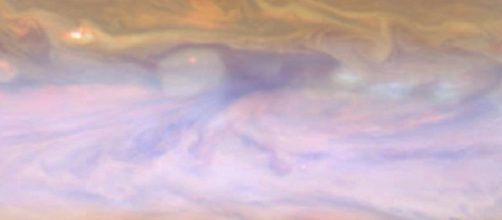Astronomers have obtained a better insight into the atmosphere of Jupiter. Using the Very Large Array (VLA) observatory, they studied the atmosphere and down to approximately 100 km below the clouds of gas. Scientists analysed this region of Jupiter at different radio wavelenghts. By matching these radio images and others made in the visible light spectrum, they obtained new results about the contents in the atmosphere of Jupiter.
Radio and optical images
Scientists used the technology of the VLA and images taken by theHubble Telescope to gather new information about Jupiter´s interior to about 100 km below the surface clouds.
By contrasting radio images against visible light images of the Great Red Spot, they discovered the up and down flow of ammonia gas, a component of the giant planet, 60 km down the top clouds in Jupiter´s atmosphere..
Rotation of gas
Although Jupiter´s belts and light – colored regions are well associated to radio features, recent radio images demonstrated that similar features are non related to visible light features. Scientists believe that the rising and sinking clouds of gases are part of the process that creates hot spot features in Jupiter´s atmosphere.
This new study provides essential pristine information in relation to the interchange of gases at these layers of the atmosphere and it also provides new data about the pressures, concentrations and temperatures that evolve there.
The results, along with further analyses, may help resolve various impórtant questions about Jupiter.
Radio astronomy
This area studies astronomical bodies that give off radio waves. With radio waves, scientists study phenomena that are invisible in other portions of the electromagnetic spectrum. Astronomers are able to witness the birth of new stars, systems of planets forming, perceive the echo of the Big Bang, galaxies, and early forming stars. With radio waves, scientists can penetrate areas in the universe that cannot be detected in visible light and they also permit the detection the motion and density of hydrogen, a gas that makes up three fourths of the universe.

